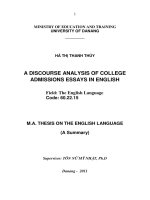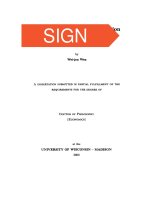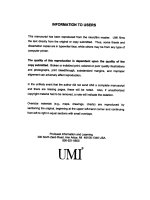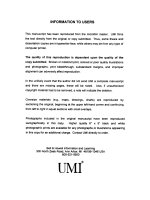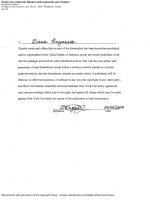essays in international finance
Bạn đang xem bản rút gọn của tài liệu. Xem và tải ngay bản đầy đủ của tài liệu tại đây (869.19 KB, 146 trang )
UMI Number: 3297894
3297894
2008
UMI Microform
Copyright
All rights reserved. This microform edition is protected against
unauthorized copying under Title 17, United States Code.
ProQuest Information and Learning Company
300 North Zeeb Road
P.O. Box 1346
Ann Arbor, MI 48106-1346
by ProQuest Information and Learning Company.
ii
Abstract
The two essays in this dissertation are concerned with investors’ decision making in
the global environment. Finance literature has established that investors do not
allocate their investments in mean variance efficient portfolios. Instead, variables
such as economic development and familiarity impact the portfolio allocation at home
and abroad. In my first essay, I investigate determinants of foreign diversification by
more than thirty thousand institutions worldwide. Survey-based country-specific
variables on cross-cultural behavior help to explain both home bias and
diversification among foreign equities. In particular, investment funds from countries
characterized by higher uncertainty avoidance behavior display greater home bias and
are less diversified in their foreign holdings. Investors from countries with higher
levels of individualism and masculinity display lower levels of home bias and are
more diversified abroad. In my second essay, I examine 3,487 non-US institutions’
portfolio allocations in US securities. International funds from geographically distant
countries invest less in the US and in a narrower set of securities than institutions
from geographically nearby countries. However the significance from geographical
distance reduces, when I control for the time zone differential between the investor
country and the US. This shows that information flow at least partially explains the
familiarity based explanation of international diversification. I also show that cultural
uncertainty avoidance impacts portfolio allocation, so that funds from countries with
high uncertainty avoidance tend to underweight the US market, but overweight a
small set of US benchmark portfolios with the amount they invest in the US.
iii
Acknowledgements
Completing this dissertation would not have been possible without many important
people who have played a part in my life both professionally and personally.
I would like to thank the Ph.D. team and Charly Edmonds as well as the entire
Finance Department at the University of Kansas for all the support they have
provided over the years. I would like to thank my committee members Audra Boone,
Bob DeYoung and Ted Juhl for all the suggestions they have given me on my
dissertation essays.
I would also like to thank Mark Fedenia for providing me with the access to
most of the data used in this research and also for his hospitality during my visits to
university of Wisconsin and his helpful suggestions on this work and also my future
wok on global investing. I hope our work together will continue for many years after
this project is finished.
I also want to thank my advisors and co-chairs Mark Hirschey and Chris
Anderson for so many things I cannot possibly list in this short paragraph. I want to
thank Mark for believing in my ability since the day I met him and during the times I
did not believe in myself. I want to thank Mark for teaching me what it takes to be a
successful academic and that completing this dissertation is just the first step in my
career in academia and for making me understand that success comes from hard work
and getting papers submitted.
Chris has taught me so much about how to develop as a researcher and how to
find great ideas. He has taught me that a great idea cannot be successful unless it is
iv
marketed in the right package. I truly admire his talent in idea generation and taking
work to the next level and selling it to the journals. I am still humbled every day by
his ability and talent and how he makes me realize how much there is still to learn.
Because of Mark and Chris I am confident that I am ready to stand on my own when I
leave Kansas, and I believe we will have many more projects to work on in the years
to come.
I also want to thank my family for their support over the years and for never
pressuring me to go and get a “real job”. Lastly, I want to thank Sasha for his endless
support during the dissertation process and the job search.
v
Table of Contents
ACCEPTANCE PAGE……………………………………………………………… i
ABSTRACT………………………………………………………………………. ii
ACKNOWLEDGEMENTS………………………………………………………. iii
CHAPTER 1
THERE’S NO PLACE LIKE HOME:
Cultural Influences on International Diversification by Institutional Investors… 1
ABSTRACT………………………………………………………………………. 2
1. Introduction…………………………………………………………… 3
2. Home bias, international diversification, and the effects of culture……. 5
2.1. International diversification and home bias……………… 5
2.2. Culturally rooted behaviors and financial decision making 7
2.3. Testable hypotheses………………………………………… 10
3. Data and methods……………………………………………………… 14
3.1. Data…………………………………………………………… 14
3.2. Measuring home bias…………………………………………. 17
4. Results……………………………………………………………… 22
4.1 Determinants of home bias…………………………………… 22
4.2. Determinants of foreign investment and concentration……… 27
4.3. Determinants of foreign diversification……………………… 29
5. Conclusion………………………………………………………………. 33
References………………………………………………………………. 37
Appendix A. Deriving home bias……………………………………… 40
CHAPTER 2
Effects of Information, Familiarity, and Culture on Stock Selection by International
Institutions in the United States………………………………………………… 69
ABSTRACT……………………………………………………………………… 70
1. Introduction …………………………………………………………… 71
2. Literature Review……………………………………………………… 74
2.1 Introduction………………………………………………… 74
2.2 Diversification and Security Selection by
International Investors………………………………………… 74
2.3 Culture and Finance…………………………………………… 79
2.4. Hofstede and Cross-Cultural Psychology…………………… 80
3. Hypothesis development……………………………………………… 81
vi
3.1 Introduction………………………………………………… 81
3.2 Stock Selection by International Institutions………………… 81
3.3. Information versus Familiarity……………………………… 83
3.4. Culture and Stock Selection………………………………… 84
4. Data and Methodology…………………………………………………. 87
4.1 Data……………………………………………………………. 87
4.2 Construction of the Master Data………………………………. 89
4.3 Methodology…………………………………………………… 91
5. Results…………………………………………………………………… 97
5.1 US Investment by International Institutions…………………… 97
5.2 Risk Taking by International Institutions……………………… 100
5.3. US Investment and Diversification by International
Growth Funds…………………………………………………. 101
6. Conclusion………………………………………………………………. 102
References………………………………………………………………. 105
vii
LIST OF FIGURES
CHAPTER 1
Figure 1……………………………………………………………. 41
Figure 2……………………………………………………………. 42
Figure 3……………………………………………………………. 43
Figure 4……………………………………………………………. 43
Figure 5……………………………………………………………. 44
Figure 6……………………………………………………………. 44
Figure 7a…………………………………………………………… 45
Figure 7b…………………………………………………………… 45
Figure 8a…………………………………………………………… 46
Figure 8b…………………………………………………………… 46
CHAPTER 2
Figure 1……………………………………………………………. 109
Figure 2……………………………………………………………. 113
Figure 3……………………………………………………………. 118
LIST OF TABLES
CHAPTER 1
Table 1…………………………………………………………… 48
Table 2…………………………………………………………… 50
Table 3…………………………………………………………… 54
Table 4…………………………………………………………… 55
Table 5…………………………………………………………… 58
Table 6…………………………………………………………… 59
Table 7…………………………………………………………… 62
Table 8…………………………………………………………… 63
Table 9…………………………………………………………… 65
Table 10…………………………………………………………… 66
Table 11…………………………………………………………… 67
Table 12…………………………………………………………… 68
CHAPTER 2
Table 1…………………………………………………………… 122
Table 2…………………………………………………………… 125
Table 3…………………………………………………………… 126
Table 4…………………………………………………………… 130
Table 5…………………………………………………………… 132
Table 6…………………………………………………………… 134
Table 7…………………………………………………………… 136
1
CHAPTER 1
THERE’S NO PLACE LIKE HOME:
Cultural Influences on International Diversification by
Institutional Investors
2
Abstract
We investigate determinants of foreign diversification by more than thirty
thousand institutions worldwide. Survey-based country-specific variables on
cross-cultural behavior help to explain both home bias and diversification
among foreign equities. In particular, investment funds from countries
characterized by higher uncertainty avoidance behavior display greater home
bias and are less diversified in their foreign holdings. Investors from countries
with higher levels of individualism and masculinity display lower levels of
home bias and are more diversified abroad. The economic significance of
cultural variables is high and comparable in magnitude to geographical
distance, a consistent influence on foreign diversification in prior studies.
3
1. Introduction
Home bias in portfolio investment decisions refers to the overweighting of
domestic securities and the underweighting of foreign securities in global investment
portfolios. Home bias and its determinants have been widely studied in the finance
literature since seminal work by French and Poterba (1991). For example, Chan,
Covrig, and Ng (2005) show that international portfolio allocations by mutual funds
are influenced by variables based on stock market development and investor
familiarity with various foreign markets as suggested by common language, bilateral
trade flows, and geographic proximity between investor and target countries.
We investigate how cross-cultural psychology affects investment decisions by
money managers from around the world and the observed degree of home bias and
international diversification in their portfolios. Specifically, we examine the global
equity holdings of institutional portfolios and analyze how these allocations are
influenced by country-specific variables derived from survey-based research in cross-
cultural psychology. Our study contributes to the existing literature in several ways.
First, our database is one of the broadest in scope and size relative to those analyzed
in previous studies. We examine detailed equity holdings for more than twenty five
thousand institutions located in over 60 countries that have ownership in securities
from over 80 countries. For this sample we confirm a tendency toward home bias and
great dispersion in the extent of diversification across foreign equity securities.
Second, we examine how cultural variables affect institutional investment decisions
in foreign equities. Prior literature examines the effects of culture on financial
4
decisions using a country’s predominant language or religion as indicators of culture.
In contrast, we integrate country-specific measures of culture obtained from
comprehensive survey-based research in cross-cultural psychology into the analysis.
These cultural variables distinguish countries based on concepts such as uncertainty
avoidance behavior, individuality versus collectivism, masculinity versus femininity,
attitudes toward power, and long-term versus short-term orientations (Hofstede, 1980,
2001). We hypothesize that such measures affect investor and portfolio manager
appetites for domestic versus foreign securities and influence how international
portfolio allocations are distributed among alternative foreign markets.
Our results indicate that country-level uncertainty avoidance is related to the
degree of home bias in the cross-section of institutional portfolios after controlling for
macroeconomic and familiarity variables previously investigated in the literature.
Specifically, institutional portfolios from countries that display high levels of
uncertainty avoidance have significantly more home bias in their portfolios and
exhibit a lower probability of investing in any given foreign country. Also, the
proportion of institutional portfolios that is allocated abroad by funds from high
uncertainty avoidance countries tends to be less diversified and underweights a
greater proportion of foreign markets compared to funds from low uncertainty
avoidance countries. Investors from countries that display high levels of cultural
individualism and masculinity have significantly less home bias in their portfolios,
and the share of such portfolios that is allocated abroad tends to be more diversified.
5
The consideration of cultural variables increases the explanatory power of
empirical models for both home bias and foreign diversification by a significant
amount that is larger than familiarity variables such as language and distance. We
also show that cultural behaviors affect diversification decisions in developed market
and emerging markets. In addition, we find that a common language influences
investment decisions by US funds and in emerging markets, but common language
has no impact on investments made by institutional investors from European Union
countries. Distance always appears as a significant determinant of foreign investment
decisions, where nearby and presumably more familiar markets tend to be preferred
by global institutional investors.
The paper is organized as follows. Section 2 reviews the literature on
international diversification and discusses how measured differences in culture across
countries may affect investment decision making. Section 3 details the data and
methods used in the study. Section 4 provides the results on the global sample of
funds. Section 6 provides a summary and offers implications for future research.
2. Home bias, international diversification, and the effects of culture
2.1. International diversification and home bias
Home bias has been widely documented in finance literature since seminal
work by French and Poterba (1991). Home bias refers to the overweighting of
domestic securities and underweighting of foreign securities in investment portfolios.
Several studies attempt to explain biases in portfolio allocations by investors in a
6
particular market. For example, Kang and Stulz (1997) investigate the determinants
of foreign shareholdings of Japanese equities, and Dahlquist and Robertsson (2001)
investigate foreign ownership of Swedish equities. Coval and Moskowitz (1999)
show that even within the Unites States money managers show a preference for
securities of firms located nearby. Similarly, Grinblatt and Keloharju (2001) show
that distance and shared ethnicity with top management help to explain portfolio
allocations by Finnish investors.
Recent research focuses on how investor-specific, investor-country-specific,
target-country-specific, and security-specific factors affect levels of home bias and
international diversification on a global basis. Amadi (2004) examines foreign
diversification of more than thirty countries around the world, and he finds that the
small levels of foreign investment are not well diversified across international equity
markets. Amadi’s empirical analysis shows that familiarity factors such as common
language, trade, and immigration links affect foreign investment. Chan, Covrig, and
Ng (2005) show that under- or over-weighting of various world equity markets by
mutual funds is conditioned by factors such as economic development, capital
controls, stock market development, familiarity, and levels of investor protection.
1
1
Economic development variables include: GDP per capita, real GDP, trade flows, direct investment,
and country credit rating. Capital control variable is the capital flow restriction of the target country.
Stock market development is measured with market capitalization, turnover, transaction cost, and
emerging market indicator variable. Familiarity variables are common language, distance between
capital cities, and bilateral trade flows between an investor and a target. Investor protection variables
include accounting standard index, minority investor protection index, risk of expropriation, efficiency
of judicial system, and legal system variable. Lastly, some other included control variables include past
return to the target country’s major index, correlation between the investor’s home market and the
target’s markets, and finally the amount of tax withheld from foreign investors.
7
Leuz, Lins, and Warnock (2005) report that quality of corporate governance practices
at the firm level influence foreign shareholdings by US investors. Ferreira and Matos
(2006) utilize a similar dataset to the one used in our study on institutional investors’
stock holdings and investigate US, non-US foreign, and domestic managers’
preferences for country- and firm-level characteristics. All three groups of
institutions reveal a strong preference for large and liquid stocks with good
governance practices. Non-US investors, however, overweight stocks that are cross-
listed in the US, are members of MSCI indexes, and firms that are globally visible
through foreign sales or analyst coverage, whereas domestic investors seem to
underweight the same stocks.
2.2. Culturally rooted behaviors and financial decision making
Financial decision making by individuals appears to vary by identifiable social
or behavioral traits. For example, Barber and Odean (2001) show that an investor’s
sex helps to predict self-attribution biases and trading activity. Even professional
money managers in the US appear to show a bias toward local stocks, perhaps
indicative of limited attention spans or over-fixation on familiar companies (Coval
and Moskowitz, 1999). More directly relevant to the home bias puzzle, Graham,
Harvey, and Huang (2006) show that individual investors who describe themselves as
competent – perhaps overconfidently – have more internationally diversified
portfolios.
8
Culture is often defined as a system of shared values, beliefs, and attitudes
that influences individual perceptions and behaviors. The effect of culture has been a
topic in many recent studies in the field of financial economics, but frequently culture
has been defined or measured in order to help explain variation in institutions or legal
practices rather than individual investor behavior.
2
In contrast, a recent series of
papers by Guiso, Sapienza, and Zingales (2004, 2005, 2006, 2007) show that cross-
cultural differences in trust in others, and especially of foreigners, helps explain stock
market participation and other facets of portfolio investment. Similarly, Chui,
Titman, and Wei (2005) suggest that cross-cultural differences in terms of
individualism versus collectivism are related to prevalence of self-attribution biases,
levels of trading activity, and the magnitude of momentum affects in security pricing
across countries.
In this study we investigate how cross-cultural differences in behavior affect
international portfolio allocations. We link a well-known study by social
psychologist Geert Hofstede on cross-cultural psychology to the international
diversification literature. Hofstede’s Culture Consequences (1980, 2001) is one of
the most influential works in cross-cultural psychology, one of the most cited studies
in the entire Social Science Citation Index, and has been widely cited in academic
research in marketing and international business. The study identifies primary
dimensions of culture and differences in thinking, values, and social behaviors among
2
For example, see Stulz and Williamson (2003), who study how a country’s principal religion helps to
explain variation in the nature and enforcement of creditor rights around the world. In contrast, see the
previously cited study by Grinblatt and Keloharju (2001), who measure culture in Finland as Finnish or
Finnish-Swedish ethnic heritage; investors in Finland tend to invest more in companies headed by
CEOs who share their heritage.
9
people from more than 50 nations. Hofstede’s survey-based evidence shows that
countries’ cultural attributes can be measured in five primary dimensions (from Geert
Hofstede’s website: and from Culture
Consequences, 2001, 2
nd
edition, pages xix-xx):
1. Uncertainty avoidance index (UAI) deals with a society's
tolerance for uncertainty and ambiguity. It indicates to what extent
a culture programs its members to feel either uncomfortable or
comfortable in unstructured situations. Unstructured situations are
novel, unknown, surprising, different from usual. Uncertainty
avoiding cultures try to minimize the possibility of such situations
by strict laws and rules, safety and security measures, and
uncertainty avoiding countries are also more emotional, and
motivated by inner nervous energy.
2. Individualism (IDV) on the one side versus its opposite,
collectivism, is the degree to which individuals are integrated into
groups. On the individualist side we find societies in which the ties
between individuals are loose: everyone is expected to look after
him/herself and his/her immediate family. On the collectivist side,
we find societies in which people from birth onwards are
integrated into strong, cohesive groups.
3. Power distance index (PDI) is the extent to which the less
powerful members of organizations and institutions accept and
expect that power is distributed unequally. It suggests that a
society's level of inequality is endorsed by the followers as much
as by the leaders. Power and inequality are extremely fundamental
facts of any society and that all societies are unequal, but some are
more unequal than others.
4. Masculinity (MAS) versus femininity refers to the distribution of
roles between the genders. The survey studies reveal that (a)
women's values differ less among societies than men's values; (b)
men's values from one country to another contain a dimension
from very assertive and competitive and maximally different from
women's values on the one side, to modest and caring and similar
to women's values on the other. The assertive pole has been called
'masculine' and the modest, caring pole 'feminine'. The women in
feminine countries have the same modest, caring values as the
men; in the masculine countries they are somewhat assertive and
competitive, but not as much as the men, so that these countries
show a gap between men's values and women's values.
10
5. Long-Term Orientation (LTO) versus short-term orientation: this
fifth dimension was found in a study among students in 23
countries around the world. Values associated with Long-Term
Orientation are thrift and perseverance.
Hofstede scores for all available countries are presented in Table 1 which ranks
the countries in order from the lowest to highest based on uncertainty avoidance
behavior. It is not immediately apparent that uncertainty avoidance would be
correlated with another country characteristic, for example with GDP per capita.
Lowest uncertainty avoidance countries include both wealthy and developing
countries from all continents.
In this study we focus on the uncertainty avoidance, individualism, and
masculinity dimensions of investor countries. Hofstede’s uncertainty avoidance
measure has not been studied before in international diversification literature.
However, a few papers have considered uncertainty avoidance in the international
economics literature. For example, Huang (2004) finds that countries characterized by
high uncertainty avoidance grow disproportionately more slowly in industry sectors
where information is less available. As noted earlier, individualism has been studied
previously in finance by Chui, Titman, and Wei (2005) in terms of its effect on self-
attribution biases, trading activity, and momentum patterns in stock returns. To our
knowledge Hofstede’s measure for masculinity has not been studied before in finance
literature.
2.3. Testable hypotheses
11
Culture’s relation to home bias or international diversification has not been
established in international finance literature. We investigate how cross-cultural
differences in behaviors as measured by Hofstede affect portfolio allocation decisions
by investment funds from around the world. We focus in particular on how
uncertainty avoidance, individualism, and masculinity affect international
diversification. We examine two aspects of international diversification, home bias
and, in addition, the extent to which the international investments are diversified
across foreign markets.
Conventional portfolio theory would predict that investors diversify across
imperfectly correlated domestic and foreign markets to maximize portfolio efficiency
(Markowitz, 1952; Levy and Sarnat, 1970). Home bias is the extent to which home-
country portfolio allocations exceed benchmark weights based on market
capitalization relative to global market capitalization, sometimes adjusted for
investability or effective float. We hypothesize that funds from countries which rank
high on the uncertainty avoidance dimension prefer safe and familiar investments.
Therefore, we expect to observe that funds from high uncertainty avoidance countries
prefer investments at home and experience higher home bias than funds from
relatively low uncertainty avoidance countries. More formally:
H1: Funds from countries characterized by high uncertainty avoidance display more
home bias in their portfolio allocations.
12
We use the phrase foreign diversification to refer to the extent that a fund’s
international portfolio allocation is diversified across foreign markets relative to
benchmark weights based on market capitalization or float-adjusted capitalization.
Again, traditional portfolio theory recommends that international allocations be
diversified across foreign markets. Merton (1987), however, argues that information
imperfections prompt investors to focus on familiar opportunities. A focus on the
known or the familiar is sometimes referred to as a habitat effect (Barberis, Shleifer,
and Wurgler, 2005). Empirical literature has shown that familiarity and/or perceived
informational advantages may lead to unbalanced portfolios so that prominent or
familiar firms are preferred (Coval and Moskowitz (1999, 2001), Kacperczyck, Siam,
and Zheng (2005)). Extant empirical literature provides support for Merton’s
argument in international setting, where investments by investors in foreign markets
are typically allocated to large, less risky, and prominently visible firms (Kang and
Stulz (1997), Dahlquist and Robertsson (2001), Ferreira and Matos (2006)) We
predict that funds from countries characterized by high uncertainty avoidance will
have foreign diversification concentrated in few large and visible firms from major
foreign markets and disproportionately less diversification to smaller riskier firms in
the majority of the target countries. In other words, we hypothesize that investors
from high uncertainty avoidance countries allocate their investments in few familiar
target countries and that low uncertainty avoidance countries allocate capital in more
target countries. Formally:
13
H 2: Funds from countries characterized by high uncertainty avoidance will display
less diversification among foreign markets.
The Hofstede measure for individualism distinguishes countries based on
whether their residents display individualistic versus collectivist behavioral
tendencies. Chui, Titman, and Wei (2005) suggest that investors from countries with
higher individualism scores may suffer from higher degree of overconfidence or
similar self-attribution biases, which in turn translates to higher trading volume.
Graham, Harvey, and Huang (2006) show that individual US investors who perceive
themselves as competent – perhaps overconfidently – have lower home bias in their
portfolios. We predict that funds from countries characterized by higher
individualism will display more dispersion among foreign markets in their portfolio
allocations. We argue that countries with higher individualism scores and possibly
higher degrees of overconfidence may on average think that they possess more
information than investors from other countries or that they interpret information
from variety of foreign markets better. The perceived information advantage by
investors from high individualism countries would then also lead to a higher number
of securities in foreign countries and more foreign diversification on average. Thus
we investigate two additional hypotheses:
H 3: Funds from countries characterized by high individualism have more ownership
abroad and therefore lower home bias than countries with low individualism scores.
H4: Funds from countries characterized by high individualism have more dispersed
portfolio allocations among foreign markets.
14
The third Hofstede measure for masculinity distinguishes countries based on
whether their residents display masculine versus feminine behavioral tendencies.
Barber and Odean (2001) suggest that male investors may suffer from higher degree
of overconfidence or similar self-attribution biases, which in turn translates to higher
trading volume in individual portfolios. Investors who perceive themselves as
competent may have lower home bias in their portfolios, so we predict that funds
from countries characterized by higher masculinity will display more dispersion
among foreign markets in their portfolio allocations. We argue that countries with
higher masculinity scores and possibly higher degrees of overconfidence may on
average think that they possess more information than investors from other countries
or that they interpret information from variety of foreign markets better. The
perceived information advantage by investors from high masculinity countries would
then also lead to a higher number of securities in foreign countries and more foreign
diversification on average. Thus we investigate the hypotheses:
H 5: Funds from countries characterized by high masculinity have more ownership
abroad and therefore lower home bias than countries with low masculinity scores.
H 6: Funds from countries characterized by high masculinity have more dispersed
portfolio allocations among foreign markets.
3. Data and methods
3.1. Data
The data are collected from several different sources of public filings. Table 3
summarizes the data sources of holdings data, fund types, and styles. Altogether the
15
initial data include fund holdings for more than 37,000 investment institutions from
over 60 countries that in turn hold securities from more than 100 countries. The total
number of distinct securities held by sample funds exceeds twenty thousand. Each of
the institutions in the dataset is identified by a unique identifier, and the portfolio data
include information on each security held in a fund’s portfolio at year-end 2006 as a
percentage of the fund’s total portfolio. Data also include the funds’ domiciles,
descriptions of style of the fund, turnover, and identifiers for each of the securities
held. We merge the portfolio holdings data to a securities database that consists of
information collected from CRSP, DataStream, and WorldScope. For each security
we have information on market value, industry, exchange, closing prices, company
name, shares outstanding, and the home country. We have multiple observations for
cross-listed firms because companies with multiple listings appear with different
identifiers in the data. We treat both an investment in cross-listed and direct
investment as an investment in the firm’s home country. The world capitalization and
bias measures we describe below incorporate the market values from both cross-listed
and home market stocks.
We merge the institutions’ descriptive data to holdings data using the unique
holder’s identifier. This allows us to define each fund’s home country, and we drop
all those funds from the sample that do not report a country code. Altogether this
reduces the number of institutions from 37,346 to 36,580. We also delete those
holding observations that do not have the percentage portfolio available or if a
security is missing its unique identifier. We drop 75 funds from the sample whose
16
holdings that do not add up to 100%. Also, roughly 1.59% (or 94,410) of all the
observations are missing the name of security’s home country. These securities are
mostly minor holdings, but in some instances they consist of a large proportion of
funds’ holdings because cash, bonds, options, and short positions appear without a
country identifier. We delete all those funds whose non-stock positions consist of
more than 50% of their holdings, Funds with zero percent invested abroad are not
included in the calculations. Also funds from countries without GDP per capita,
Hofstede dimensions, and language and distance data are excluded and 25,430 equity
funds remain.
Some of the securities in many countries appear difficult or impossible for
foreign investors to obtain either because of legal restrictions or because of ownership
by large block holders. For each security we therefore calculate the investable float
as the percentage (and market value) of shares that are not held by large block holders
as reported by WorldScope.
Other country-specific variables are collected from several different sources.
GDP, GDP per capita, projected GDP growth, exchange rate data, and inflation data
for investor countries are obtained from United States Department of Agriculture.
3
Hofstede scores for the primary dimensions of culture are obtained from Geert
Hofstede’s website.
4
Corporate governance as well as corruption and transparency
indexes for the target countries come from Maplecroft.
5
Bilateral trade flows are from
3
United States Department of Agriculture:
4
Geert Hofstede’s dimensions of culture:
5
Global Risk Scores:
